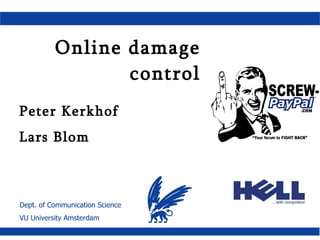
Online damage control
- 1. Online damage control Peter Kerkhof Lars Blom
- 17. Resultaten
- 18. Resultaten
- 19. Resultaten
- 20. Resultaten
Notas del editor
- Ca. 2/3 van consumenten (Deloitte, 2007) gebruikt ze, 80% wordt erdoor beinvloed. Effecten op boekverkoop bij Amazon.com/Barnesandnoble.com, vooral van negatieve reviews Productevaluaties (zie Ivar)
- Sen Lerman We find that compared with the utilitarian case,readers of negative hedonic product reviews are more likely to attribute the negative opinions expressed, to the reviewer’s internal (or non- product related) reasons; and therefore are less likely to find the negative reviews useful. However, in the utilitarian case, readers’ are more likely to attribute the reviewer’s negative opinions to external (or product related) moti- vations,and therefore find negative reviews more useful than positive reviews on average. Listening to strangers: provider’s response speed, the extent to which the provider’s previous responses within the focal domain have been positively evaluated by others, and the breadth of the provider’s previous responses
- Philips: klant in zijn waarde late Voorbeelden webcare teams: Vodaphone, T-Mobile, UPC Iblue voorbeeld
- Een hoge mate van merkbetrokkenheid zorgt ervoor dat negatieve reviews een minder sterk effect hebben op de attitude van de consument (Ahluwalia et al., 2000). Laagbetrokkenen verwerken de negatieve informatie objectief en zoals eerder al naar voren is gekomen heeft negatieve informatie meer invloed op de vorming van attitudes dan positieve informatie. Hoogbetrokkenen blijken tegenargumenten te formuleren om de negatieve informatie te neutraliseren. Verder benadrukken zij de positieve informatie en eigenschappen van het betreffende product of merk bij de attitude vorming (Ahluwalia et al. 2000; Einwiller, Fedorikhin, Johnson & Kamins, 2006).
